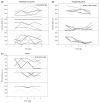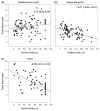Competition avoidance drives individual differences in response to a changing food resource in sticklebacks
- PMID: 23489482
- PMCID: PMC3972385
- DOI: 10.1111/ele.12105
Competition avoidance drives individual differences in response to a changing food resource in sticklebacks
Abstract
Within the same population, individuals often differ in how they respond to changes in their environment. A recent series of models predicts that competition in a heterogeneous environment might promote between-individual variation in behavioural plasticity. We tested groups of sticklebacks in patchy foraging environments that differed in the level of competition. We also tested the same individuals across two different social groups and while alone to determine the social environment's influence on behavioural plasticity. In support of model predictions, individuals consistently differed in behavioural plasticity when the presence of conspecifics influenced the potential payoffs of a foraging opportunity. Whether individuals maintained their level of behavioural plasticity when placed in a new social group depended on the environmental heterogeneity. By explicitly testing predictions of recent theoretical models, we provide evidence for the types of ecological conditions under which we would expect, and not expect, variation in behavioural plasticity to be favoured.
© 2013 John Wiley & Sons Ltd/CNRS.
Figures




Similar articles
-
Intraspecific competition drives increased resource use diversity within a natural population.Proc Biol Sci. 2007 Mar 22;274(1611):839-44. doi: 10.1098/rspb.2006.0198. Proc Biol Sci. 2007. PMID: 17251094 Free PMC article.
-
Small Variations in Early-Life Environment Can Affect Coping Behaviour in Response to Foraging Challenge in the Three-Spined Stickleback.PLoS One. 2016 Feb 10;11(2):e0147000. doi: 10.1371/journal.pone.0147000. eCollection 2016. PLoS One. 2016. PMID: 26862908 Free PMC article.
-
Sticklebacks from streams are more bold than sticklebacks from ponds.Behav Processes. 2007 Nov;76(3):215-7. doi: 10.1016/j.beproc.2007.05.004. Epub 2007 May 18. Behav Processes. 2007. PMID: 17583445
-
The social structure and strategies of delphinids: predictions based on an ecological framework.Adv Mar Biol. 2007;53:195-294. doi: 10.1016/S0065-2881(07)53003-8. Adv Mar Biol. 2007. PMID: 17936137 Review.
-
An evolutionary framework outlining the integration of individual social and spatial ecology.J Anim Ecol. 2018 Jan;87(1):113-127. doi: 10.1111/1365-2656.12773. Epub 2017 Nov 27. J Anim Ecol. 2018. PMID: 29055050 Review.
Cited by
-
Time constraints may pace the ontogeny of movement behaviour.Proc Biol Sci. 2023 Apr 12;290(1996):20222429. doi: 10.1098/rspb.2022.2429. Epub 2023 Apr 5. Proc Biol Sci. 2023. PMID: 37015276 Free PMC article.
-
Suppression force-fields and diffuse competition: competition de-escalation is an evolutionarily stable strategy.R Soc Open Sci. 2023 Aug 30;10(8):230222. doi: 10.1098/rsos.230222. eCollection 2023 Aug. R Soc Open Sci. 2023. PMID: 37650054 Free PMC article.
-
The multidimensional behavioural hypervolumes of two interacting species predict their space use and survival.Anim Behav. 2017 Oct;132:129-136. doi: 10.1016/j.anbehav.2017.08.010. Epub 2017 Sep 5. Anim Behav. 2017. PMID: 29681647 Free PMC article.
-
Extensive behavioural divergence following colonisation of the freshwater environment in threespine sticklebacks.PLoS One. 2014 Jun 10;9(6):e98980. doi: 10.1371/journal.pone.0098980. eCollection 2014. PLoS One. 2014. PMID: 24914554 Free PMC article.
-
The adaptive value of density-dependent habitat specialization and social network centrality.Nat Commun. 2024 May 24;15(1):4423. doi: 10.1038/s41467-024-48657-8. Nat Commun. 2024. PMID: 38789438 Free PMC article.
References
-
- Beauchamp G. Learning rules for social foragers: implications for the producer-scrounger game and ideal free distribution theory. J Theo Biol. 2000;207:21–35. - PubMed
-
- Bell AM. Behavioural differences between individuals and two populations of stickleback (Gasterosteus aculeatus) J Evol Biol. 2005;18:464–473. - PubMed
-
- Bolnick DI, Svanback R, Fordyce JA, Yang LH, Davis JM, Hulsey CAD, et al. The ecology of individuals: incidence and implications of individual specialization. Am Nat. 2003;161:1–28. - PubMed
-
- Clark CJ, Mangel M. Dynamic State-Dependent Models in Ecology. Oxford University Press; New York, NY: 2000.
Publication types
MeSH terms
Grants and funding
LinkOut - more resources
Full Text Sources
Other Literature Sources

